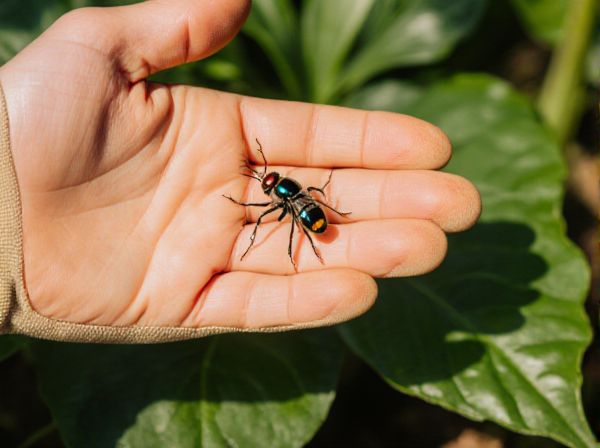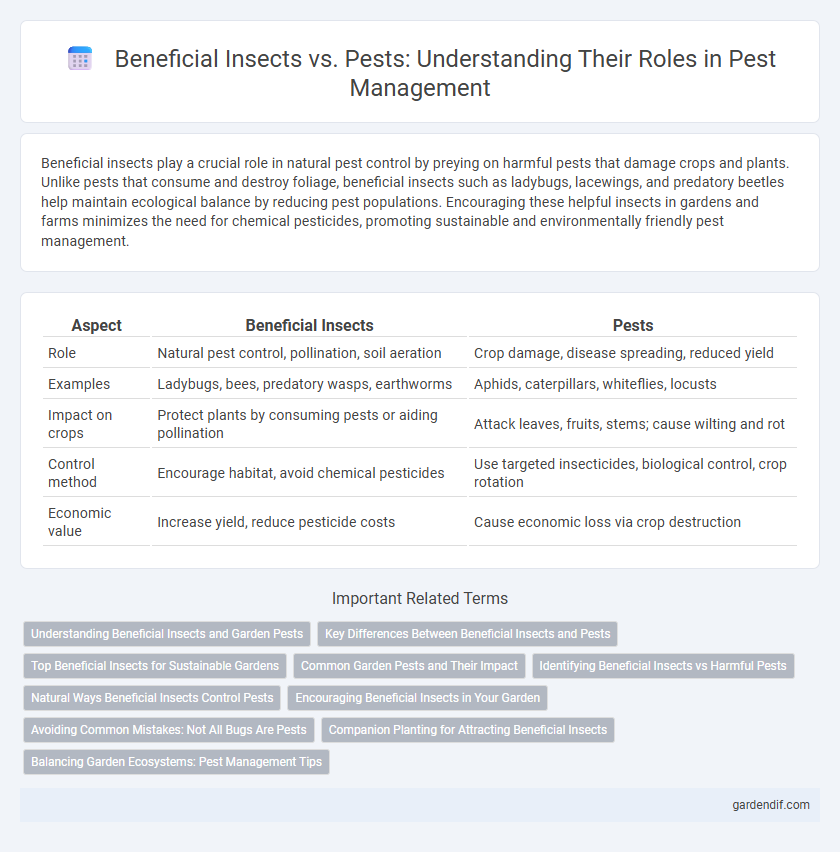
Beneficial insects vs Pests Illustration
Beneficial insects play a crucial role in natural pest control by preying on harmful pests that damage crops and plants. Unlike pests that consume and destroy foliage, beneficial insects such as ladybugs, lacewings, and predatory beetles help maintain ecological balance by reducing pest populations. Encouraging these helpful insects in gardens and farms minimizes the need for chemical pesticides, promoting sustainable and environmentally friendly pest management.
Table of Comparison
| Aspect | Beneficial Insects | Pests |
|---|---|---|
| Role | Natural pest control, pollination, soil aeration | Crop damage, disease spreading, reduced yield |
| Examples | Ladybugs, bees, predatory wasps, earthworms | Aphids, caterpillars, whiteflies, locusts |
| Impact on crops | Protect plants by consuming pests or aiding pollination | Attack leaves, fruits, stems; cause wilting and rot |
| Control method | Encourage habitat, avoid chemical pesticides | Use targeted insecticides, biological control, crop rotation |
| Economic value | Increase yield, reduce pesticide costs | Cause economic loss via crop destruction |
Understanding Beneficial Insects and Garden Pests
Beneficial insects, such as ladybugs and predatory beetles, naturally control garden pests by feeding on aphids, mites, and caterpillars, reducing the need for chemical pesticides. Garden pests like aphids, whiteflies, and spider mites damage plants by sucking sap and spreading diseases, leading to weakened growth and lower crop yields. Understanding the roles of both beneficial insects and pests helps gardeners implement integrated pest management strategies that promote plant health and maintain ecological balance.
Key Differences Between Beneficial Insects and Pests
Beneficial insects like ladybugs and predatory wasps play crucial roles in natural pest control by feeding on harmful pests such as aphids and caterpillars, thereby reducing the need for chemical pesticides. Pests, including species like aphids, whiteflies, and spider mites, damage crops by feeding on plant sap or leaves, leading to reduced agricultural yields and plant health. Unlike pests, beneficial insects contribute to biodiversity and ecosystem balance, supporting sustainable agriculture and healthier gardens.
Top Beneficial Insects for Sustainable Gardens
Top beneficial insects for sustainable gardens include ladybugs, lacewings, and parasitic wasps, which naturally control aphids, caterpillars, and whiteflies. These predators reduce the need for chemical pesticides, promoting healthier plant growth and biodiversity. Introducing native pollinators like bees alongside these predators enhances crop yields and supports ecosystem balance.
Common Garden Pests and Their Impact
Common garden pests such as aphids, whiteflies, and spider mites damage plants by feeding on leaves, stems, and roots, leading to stunted growth and reduced yields. Beneficial insects like ladybugs, lacewings, and predatory wasps help control these pests by preying on eggs and larvae, naturally limiting their population. Understanding the balance between pest species and beneficial insects is crucial for maintaining garden health and minimizing chemical pesticide use.
Identifying Beneficial Insects vs Harmful Pests
Beneficial insects such as ladybugs, lacewings, and predatory wasps play a crucial role in controlling harmful pest populations like aphids, whiteflies, and spider mites by naturally reducing their numbers. Identifying these insects involves recognizing distinct features: beneficial insects often have bright colors, smaller, more agile bodies, and behaviors like hunting or pollinating, whereas harmful pests typically cause visible damage to plants, such as chewed leaves or discolored foliage. Accurate identification enhances integrated pest management strategies by promoting the conservation of beneficial species while targeting destructive pests effectively.
Natural Ways Beneficial Insects Control Pests
Beneficial insects such as ladybugs, lacewings, and parasitic wasps naturally control pest populations by preying on harmful insects like aphids, mites, and caterpillars. These predators reduce the need for chemical pesticides, promoting ecological balance and healthier crops. Their presence enhances integrated pest management strategies by targeting pest species without harming beneficial organisms.
Encouraging Beneficial Insects in Your Garden
Encouraging beneficial insects such as ladybugs, lacewings, and parasitic wasps significantly reduces pest populations by naturally preying on aphids, mites, and caterpillars. Planting diverse, native flowering plants and herbs like dill, fennel, and yarrow provides essential nectar and habitat that attract and sustain these beneficial species. Creating a balanced garden ecosystem minimizes the need for chemical pesticides, promoting healthier plant growth and improved crop yields.
Avoiding Common Mistakes: Not All Bugs Are Pests
Beneficial insects such as ladybugs, lacewings, and parasitic wasps play a crucial role in natural pest control by preying on harmful pests like aphids and caterpillars. Misidentifying these helpful species as pests and using broad-spectrum insecticides can disrupt ecological balance and lead to pest resurgence. Accurate identification and targeted pest management practices help maintain garden health and biodiversity by protecting these essential beneficial insects.
Companion Planting for Attracting Beneficial Insects
Companion planting strategically pairs plants to attract beneficial insects such as ladybugs, lacewings, and parasitic wasps, which naturally control pest populations like aphids and caterpillars. Plants like marigolds, nasturtiums, and dill emit scents that lure predatory insects, enhancing pest control without chemical intervention. This approach fosters a balanced ecosystem in gardens by promoting biodiversity and reducing the need for pesticides.
Balancing Garden Ecosystems: Pest Management Tips
Beneficial insects such as ladybugs, lacewings, and predatory beetles play a crucial role in naturally controlling pest populations like aphids, caterpillars, and whiteflies within garden ecosystems. Maintaining a balanced garden ecosystem involves planting diverse native flora to attract these beneficial insects while minimizing the use of broad-spectrum pesticides that can harm them. Integrating biological pest management strategies promotes sustainable pest control and supports long-term plant health by preserving natural predator-prey relationships.
Beneficial insects vs Pests Infographic

 gardendif.com
gardendif.com